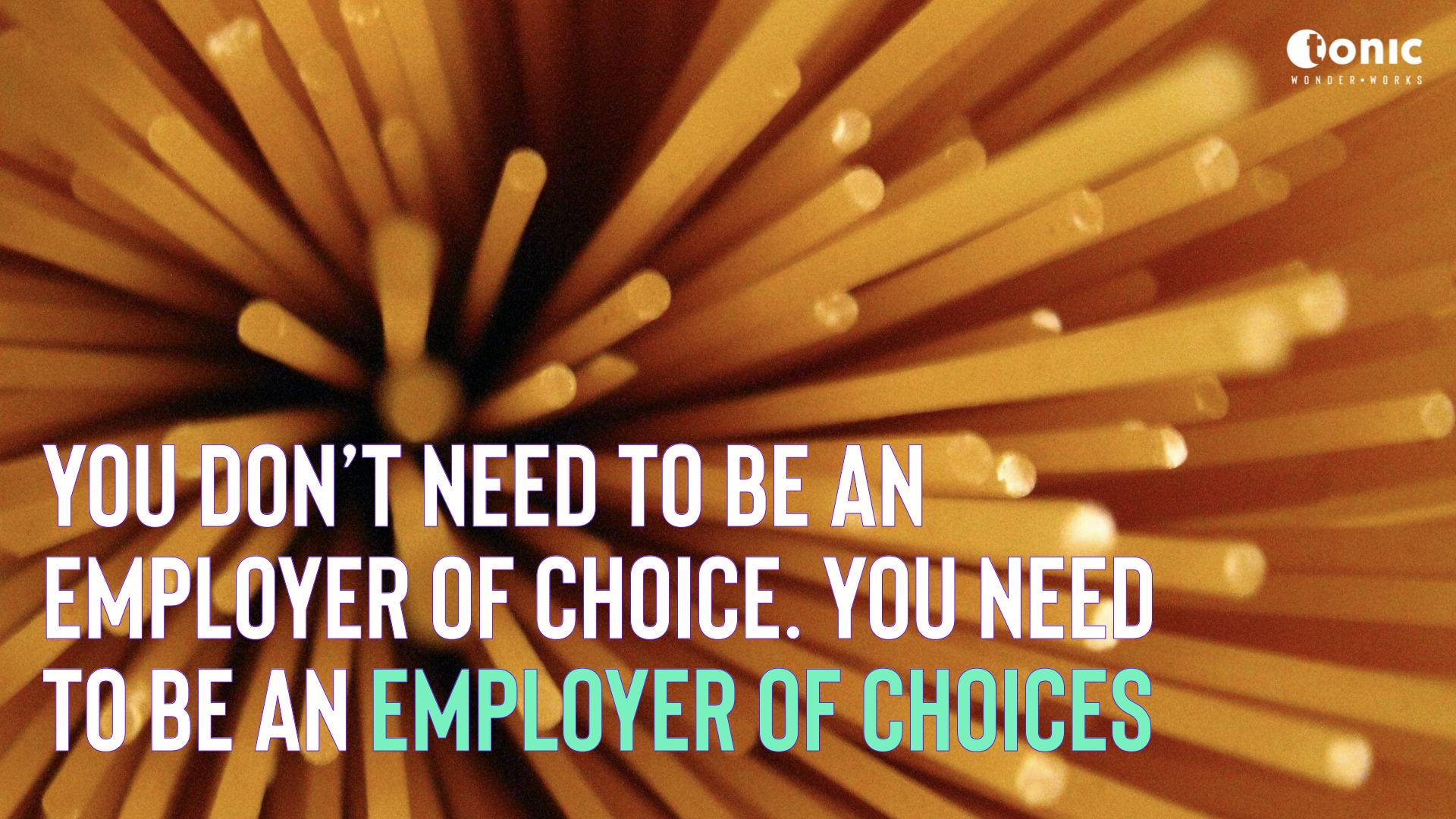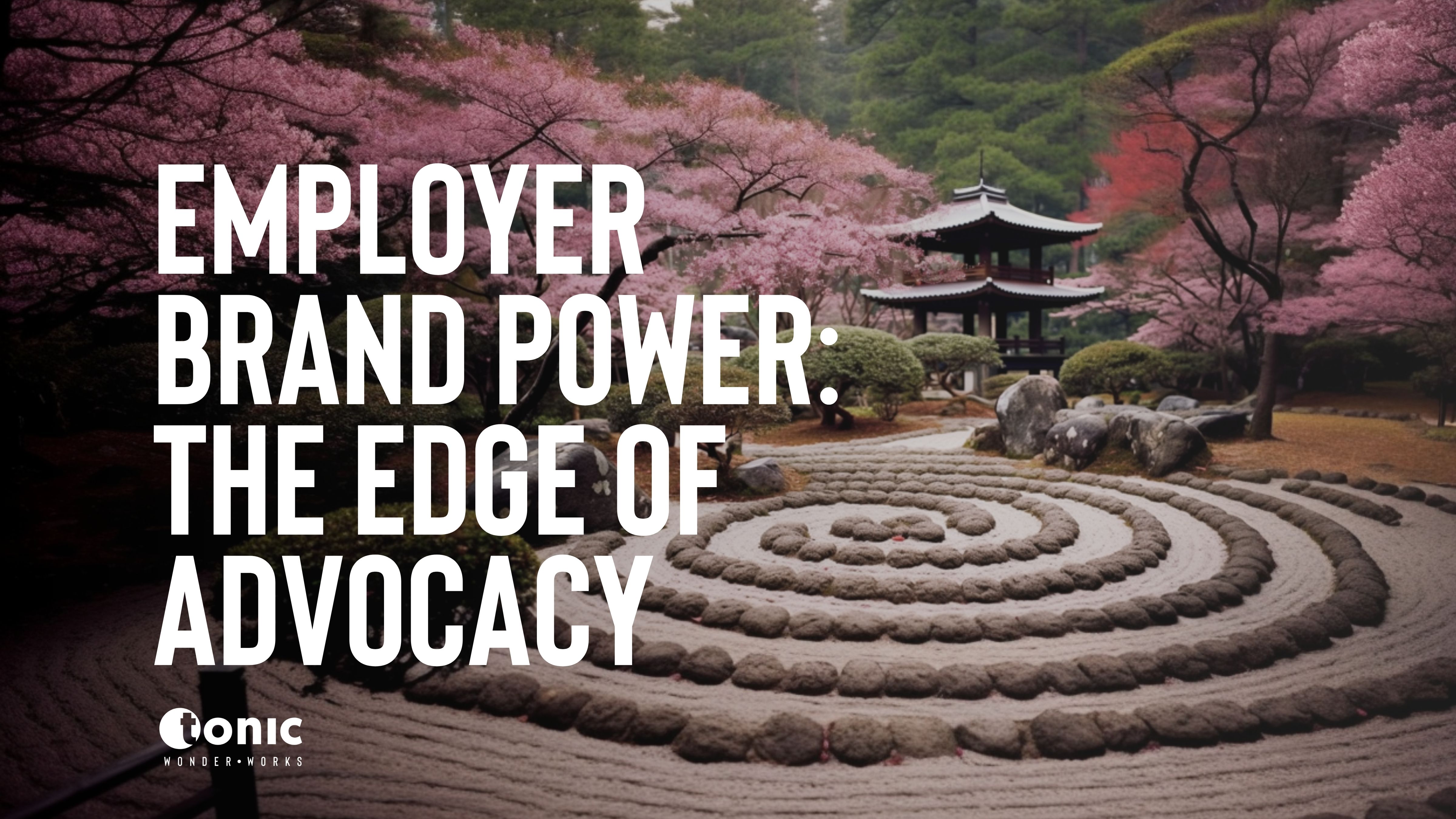If you want to be an employer of choice, do you really need to be an EMPLOYER OF CHOICES instead?
I think there’s a problem with how a lot of organisations try to become an “Employer of Choice”, and in particular it's about the way that they try to work out what that ideal looks like, and then to provide that perfect employer to everyone. I think that model is flawed. I also think it’s not very inclusive.
Firstly, your audience isn’t homogenous. Even if we just look at the people you already employ, they aren’t all the same, and want different things. I’ll give some examples later on… Secondly, you are never actually going to know what your audience really want. Because it’s almost impossible to get people to tell you what they really think, rather than what they think they ought to think. But also because sometimes we genuinely don’t know what we want until we have it, and even then might not realise what aspects of it are subconsciously the bits we like.
A “one size fits all” approach will inevitably lead to a model that at best is optimised for an average, amalgam employee. And given your current D&I stats, I’m afraid that amalgam is unlikely to represent large portions of your workforce. Being a modern, inclusive employer is much harder than being an employer of choice; you need to be an employer of choices.
Let’s talk spaghetti
In the 70s, food consultant Howard Moskowitz was not a happy man. He’d been tasked with working out the optimum amount of sweetener to put in Diet Pepsi, but the results from his testing were a mess. Having tried lots of different concentrations, there was no nice ‘peak’ in the graph of his results, and it turned out different people liked different levels - as he said “There is no perfect Diet Pepsi - only perfect Diet Pepsis”.
Years later, when working on a similar challenge to optimise spaghetti sauce, he finally had his breakthrough moment. After testing lots of different recipes on Americans, he realised that Americans actually fell into three distinct groupings - people who liked it plain, people who liked it spicy, and people who liked it chunky. And that last one was huge - because literally no company was offering a product that was chunky at that time. As he said to his clients, although most people didn’t want chunky sauce, one third of the US market was there for the taking with no competition - and his clients Prego made $600m selling it to them over the next decade.
The big idea here, of course, is that it’s a bad idea to model your audience as one homogenous lump, when it’s more likely that they are really a set of ‘tribes’ - people who have something in common with each other and you can therefore sell a product or service. I think this exact same idea has a lot of use within employment marketing.
What do employees want?
Many years ago I was having a chat with the HRD at a client as we waited for a senior stakeholder to arrive at a meeting, and he was explaining his philosophy on L&D to me. His position was that people who worked at his organisation were not just grudgingly permitted to be different from each other, but that it was genuinely a good thing if people decided what they wanted out of work, and then he tried to deliver it for them.
But not only that, he also pointed out that the same person could experience multiple changes in priorities while working for the same employer - perhaps being eager to learn at first, then shifting towards a desire for pay and promotions, and then wanting work-life balance above all, depending on what was happening in their life outside of work.
“The tricky thing, Marcus, is that I need to make sure that that person can get all those things, at the point at which they want them - and sometimes I’m also going to need to help them work out what it is that they want”
He was right - in my view, but actually it’s stuck with me because so many people don’t think that way. It’s equally applicable to the external audience we’re trying to recruit too - too often the datasets we’re relying on for what they are looking for present us with the average. The correct answer for “What do students want from a grad scheme?” for example, is quite obviously “Lots of different things. They are wildly different people”, and that’s a relatively narrow grouping…
Mapping your tribes
I think a lot of employers would do well to map out the mindsets or tribes that could exist within your organisation, and within the groups you could employ - not by seniority, department, location, or diversity grouping, but in terms of what someone might want from you as an employer.
To get you started here’s some I think probably exist in your organisation, right now:
- The enthusiast: the enthusiast loves their job, in and of itself. They are happiest when learning to do it better, or demonstrating how well they already do it. Their relationship with their employer depends on how much that employer appears to be facilitating this, or obstructing it. They will leave if they feel someone else will give them more opportunity to do the job they love.
- The earner: the earner might quite like their job, but it’s a means to an end, and that end is earning money. It might be because they want to travel the world, it might be because they are the main breadwinner for their household. Their relationship with their employer depends on pay and rewards, but also on how that employer is facilitating promotions that will come with pay rises. If they are of the breadwinning variety, stability will also be key here.
- The climber: the climber at first seems similar to the earner, but the money is incidental to their real objective - status. The climber wants an impressive job title, to move up your org chart, to attend meetings with big cheeses, to have public stages on which to speak, and things to put on their LinkedIn profile. Their relationship with their employer depends chiefly on these opportunities.
- The carer: the carer has a responsibility outside of work that is more important to them than their job right now. It might actually be a caring role, but it could be another passion potentially. What they want from you as an employer is actually not a great deal - other than dependable income, and flexibility on work patterns, remote working, or whatever else might facilitate their outside concern.
- The team player: the team player primarily enjoys work because of the collaboration with other people - sometimes because they are a naturally gregarious person, but sometimes exactly because they aren’t and work provides a useful social structure for them. What the team player does for a living is actually pretty incidental to them, and what they want is continued opportunities to collaborate - broadening their personal network as they go.
Now hopefully even just with these five tribes, you can see there’s a big difference in what they might want from you. If you optimised everything for the climber, you might be okay with the earner, but you’ll annoy all the others. Likewise, if we set up everything for the team player, we might lost the enthusiast.
Getting the data straight
If you wanted to create these tribes more scientifically, you could look at affinity mapping your staff survey responses into groups who’d responded in similar ways, but the problem there would be that we can’t rely on people having told us what they actually think if their perception is that there’s a way they are supposed to be at your organisation.
I’d be more inclined to start with a fresh research project where we asked a sample of employees to respond to some forced choices (e.g. “Would you prefer a big pay rise, or a small pay rise and a promotion”) to begin to understand what their priorities are. You’d be surprised how people answer these kinds of questions, but there are some fascinating occupational psychology studies out there on these kinds of things.
In the absence of this kind of data, the problem is we’re either assuming that anything anyone says they want is wanted by everyone (so vastly overestimating what really needs to be provided) or alternatively completely failing to spot the importance of some things - especially to those groups unlike the people making the decisions.
A call to arms
Returning to my opening theme, ultimately I’m challenging you to reject the central premise of many of these employer rankings that suggest there is some kind of universal perfect employer that everyone wants, and instead to start understanding how you might appeal to different kinds of people - even those who like chunky spaghetti sauce. It’s the more inclusive approach.
If you’d like to discuss how I could help you map the idea out, drop me a line.





